
A railcar is a self-propelled railway vehicle designed to transport passengers. The term "railcar" is usually used in reference to a train consisting of a single coach, with a driver's cab at one or both ends. Some railway companies, such as the Great Western, termed such vehicles "railmotors".

Rail transport in the Australian state of Victoria is provided by a number of railway operators who operate over the government-owned railway lines. The network consists of 2,357 km of Victorian broad gauge lines, and 1,912 km of standard gauge freight and interstate lines; the latter increasing with gauge conversion of the former. Historically, a few experimental 762 mm gauge lines were built, along with various private logging, mining and industrial railways. The rail network radiates from the state capital, Melbourne, with main interstate links to Sydney and to Adelaide, as well as major lines running to regional centres, upgraded as part of the Regional Fast Rail project.
The Tocumwal railway line is a 1,600 mm gauge railway line in Victoria, Australia. The line runs between the border town of Tocumwal in New South Wales to Southern Cross, Melbourne. The line is utilised by various passenger and freight trains serving the northern suburbs of Melbourne and northern regions of Victoria.

The Healesville railway line, in Melbourne, Australia, was the non-electrified continuation of the suburban Lilydale line, extending into the Yarra Valley. The line closed in the 1980s, but a heritage railway group, the Yarra Valley Railway, is working to retain part of the line between Yarra Glen and Healesville.

The N Class are a class of diesel locomotives built by Clyde Engineering in Somerton for V/Line between 1985 and 1987.

The B class are a class of diesel locomotives built by Clyde Engineering, Granville for the Victorian Railways in 1952–1953. Ordered and operated by the Victorian Railways, they initiated the dieselisation of the system and saw use on both passenger and freight services, with many remaining in service today, both in preserved and revenue service. Some were rebuilt as the V/Line A class, while others have been scrapped.
The Kerr Stuart steam railmotor, also known as Motor Car 3, was a steam railcar operated by the Victorian Railways from 1913 to 1924.

The Diesel Electric Rail Motor (DERM) was a type of railmotor operated by the Victorian Railways in Australia.

The DRC was a class of railmotor operated by the Victorian Railways on its country rail network in Victoria, Australia. The cars were built by Tulloch Limited in New South Wales, and featured aluminium and steel construction, air-conditioning, and twin diesel engines with hydraulic transmissions.

The T class are a class of diesel locomotives built by Clyde Engineering, Granville for the Victorian Railways between 1955 and 1968.
The MT type carriages were railmotor trailers, used on the Victorian Railways (VR) in Australia.
The New Deal for Country Passengers was a timetable introduced on 4 October 1981 in Victoria, Australia which revolutionised the provision of country passenger railway services. Thirty-five little-used passenger stations were closed, rolling stock utilisation was improved, and new rolling stock introduced. The timetable and associated service changes resulted in an average patronage growth of 8.7% per year, from 3 million in 1981 to 5.6 million passengers in 1990/91.

The family of Walker railmotors were a type of diesel railcar operated by the Victorian Railways in Australia.

Strathmerton is a closed railway station on the Goulburn Valley railway in the town of Strathmerton, Victoria, Australia. The station opened at the same time as the railway from Shepparton to Cobram on 1 October 1888, with the line to Tocumwal not opening until 28 February 1905, ending at a temporary terminus on the south side of the Murray River, the line not completed into Tocumwal until July 1908. The junction between the lines was to the north of the station, facing down trains.

Jolimont Workshops was a railway workshop operated by the Victorian Railways beside Jolimont Yard, near the Melbourne CBD, Australia. Opened in 1917 and dedicated to the maintenance and repair of electric multiple units and locomotives, it was the first part of the yard to be closed and relocated, with demolition completed in 1994. The site is now part of the Melbourne Park tennis complex.

The Cudgewa railway line is a closed railway line in the north-east of Victoria, Australia. Branching off the main North East line at Wodonga it ran east to a final terminus at Cudgewa. The High Country Rail Trail now uses most of the railway reserve.

Tulloch Limited was an Australian engineering and railway rolling stock manufacturer, located at Rhodes, New South Wales.

The Tasmanian Government Railways DP class was a class of diesel railcars operated by the Tasmanian Government Railways.
Walker Brothers Limited was a manufacturer based in Pagefield Ironworks, Wigan, England. It produced ventilation equipment for mining, truck and bus chassis, mobile cranes, and railway locomotives and railcars.















